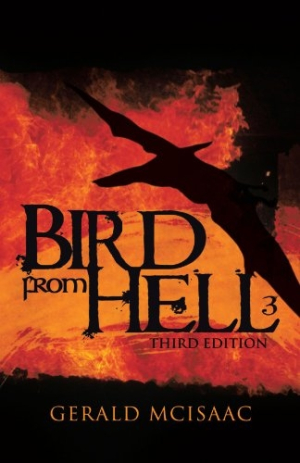Bird from Hell
Third Edition
In August 2011, a New York Times article reported that, according to researchers, 85 percent of land creatures and more than 90 percent of sea creatures have yet to be discovered. That bit of news may sound strange, particularly in an age when someone living in Manhattan can access ground-level images of the Serengeti from an online satellite map.
It’s when people go off the map that they learn that our world is bigger than it sometimes appears. Ask Gerald McIsaac. For more than thirty years, McIsaac lived with the Dene tribe in the mountainous region of northern British Columbia. There, he heard aboriginal oral histories about unusual creatures. Inspired and mystified by those tales, McIsaac compiled Bird from Hell, a collection of stories (now in its third edition) about the creatures and the author’s attempts to find proof of their existence.
Over several chapters, McIsaac proposes that the mysterious creatures the Dene have seen aren’t supernatural beings, but ancient animals long thought to be extinct. From descriptions of the “devil bird” (the “bird from hell” in the title of his book), McIsaac believes that it might be a pterodactyl that survived the age of the dinosaurs. Encounters with other creatures are suggested to be run-ins with ground sloths, woolly mammoths, and “mega bears.” Even the Sasquatch (one of which McIsaac attracts to his cabin door), the author proposes might be Neanderthal humans.
Throughout this straightforward narrative, McIsaac acknowledges that his reader may be skeptical. He writes, “For those who scoff, I can only point out that I went hunting the devil bird alone, because no one would go with me. There is no doubt at all in the minds of the Dene people that this animal exists and that it is extremely dangerous.”
Unfortunately, anecdotal evidence like this is the rule. McIsaac rarely cites sources, and, while this latest edition of his book includes pictures of his Dene witnesses, it does not include pictures of more reliable evidence, like footprints or bones.
Still, readers who are attracted to legendary creatures won’t turn to a book like Bird from Hell for scientific proof. They want accounts of creatures and adventure—like McIsaac’s search for the devil bird’s nest—and they certainly won’t be disappointed with this project. They may even be amused. For instance, when McIsaac runs into a Sasquatch, he tells how his aggressive hunting dog takes off running in the opposte direction.
For the third edition, McIsaac includes a short essay that examines the Occupy Wall Street movement’s desire to correct inequalities in economic systems and wishes a similar movement could take hold of the scientific community to research these creatures. “To suggest that these species exist is to commit career suicide,” McIsaac writes of modern scientists. “This is a sad state of affairs and must be changed.” It may take a book like Bird from Hell to inspire people to think differently.
Reviewed by
Katerie Prior
Disclosure: This article is not an endorsement, but a review. The publisher of this book provided free copies of the book and paid a small fee to have their book reviewed by a professional reviewer. Foreword Reviews and Clarion Reviews make no guarantee that the publisher will receive a positive review. Foreword Magazine, Inc. is disclosing this in accordance with the Federal Trade Commission’s 16 CFR, Part 255.

